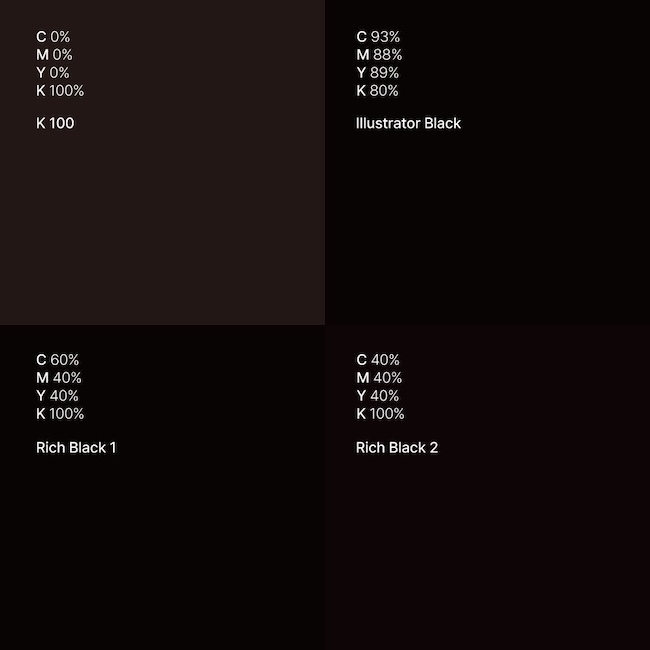When designing for print, many assume that setting black to 100% K (Key/Black) in CMYK will produce the deepest, richest black. However, this is not the case. A pure K100 black often appears as a dull, dark gray rather than a true deep black. To achieve a deeper, more intense black, designers use what is called Rich Black—a mix of CMYK values that enhances depth and vibrancy.
The Difference Between K100 and Rich Black
K100 consists of only black ink, and while it may look fine on screen, in print, it often lacks depth. On the other hand, Rich Black is created by adding varying amounts of cyan (C), magenta (M), and yellow (Y) to the black (K) ink. This mix enhances the density and richness of the black color.
Looking at the image above, the difference is clear:
- K100 (C0 M0 Y0 K100) appears as a slightly washed-out black with a brownish or grayish tint.
- Rich Black variants, such as C60 M40 Y40 K100 or C40 M40 Y40 K100, appear much deeper and more saturated.
- Illustrator Black (C93 M88 Y89 K80) is another variation that results in a very rich, dark black.

Choosing the Right CMYK Values for Rich Black
There is no universal CMYK formula for Rich Black—designers use different mixes based on printing conditions, paper type, and personal preference. Some common combinations include:
- Standard Rich Black: C60 M40 Y40 K100
- Warm Black: C40 M60 Y40 K100 (adds warmth with extra magenta)
- Cool Black: C70 M30 Y30 K100 (leans toward a bluish tone)
CMYK Total Ink Limit: Avoiding Over-Saturation
While adding more ink enhances the richness of black, there’s a critical limit to consider. The total ink coverage (C+M+Y+K) should not exceed 300%, as excessive ink can lead to smudging, longer drying times, and poor print quality. For example:
- C60 M40 Y40 K100 = 240% total ink (acceptable)
- C80 M70 Y70 K100 = 320% total ink (too high, may cause issues)
Conclusion
If you want a deep, intense black in your printed materials, do not rely solely on K100. Instead, use a carefully chosen Rich Black formula while ensuring the total ink coverage stays within safe limits. Each designer may prefer a slightly different mix, so testing and communicating with your printer is essential for the best results.
By understanding and applying Rich Black properly, you can achieve a more professional and visually striking final print.
